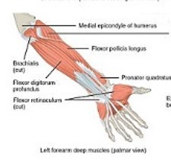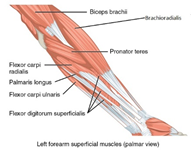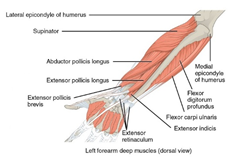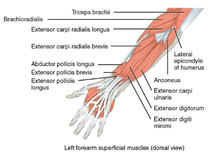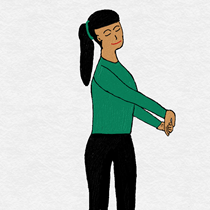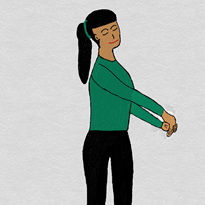|
Forearm stretch
This week we will see the two forearm stretches: i) volar or anterior forearm stretch for the flexor muscles, and ii) dorsal or posterior forearm stretch for the extensor muscles. The biceps and brachialis muscles insert on the anterior aspect of forearm, distal to the elbow joint. Another set of muscles which originates from the medial epicondyle of the humerus, traverses the front of the forearm and inserts at various points near the wrist and hand. These are the common flexors of the wrist/ hand/ fingers and the pronator teres. The triceps inserts on the olecranon process of the ulna (which is a forearm bone), just distal to the elbow joint. A set of muscles which originates from the lateral epicondyle of the humerus and inserts at various points near wrist and hand. These are the common extensors of the wrist/hand/fingers and the supinator. Any repetitive motion of the hand, wrist or turning of the forearm may lead to pain near the elbow usually due to inflammation of the common flexor tendons (golfers elbow) or the common extensor tendons (tennis elbow). Passive stretching and soft tissue mobilization One may very easily do self-mobilization for these muscle groups and follow up with gentle active stretches to release the muscles and perform eccentric muscle contractions to strengthen the muscles through the full released range of motion. * Sit upright in a chair with back rest and neutral spine with both feet supported on the floor. * Place a pillow on your lap and rest the right forearm on the pillow with palm facing upwards. This makes the volar or anterior forearm available for mobilization. * Bring the left thumb pad slightly distal to the inner/medial side of the right elbow, below the elbow crease. Begin by gently pressing the thumb into the soft tissue and move in small circles. Slide the thumb towards the wrist in small increments repeating the circles. You will distinctly detect tender points and can emphasize specific release by working locally over that area. Also you may slide the thumb side to side over the muscle bulk (proximal half of forearm) and hold mild pressure over detected tender points for 5-20 seconds(this should be to tolerance and not be painful). * * Now place the right forearm on the pillow across your lap with palm facing down. This makes the dorsal or posterior forearm available for mobilization. * * Bring the left thumb pad slightly distal to the outer /lateral side of the right elbow, below the elbow crease. Begin by gently pressing the thumb into the soft tissue and move in small circles. Slide the thumb towards the wrist in small increments repeating the circles. You will distinctly detect tender points and can emphasize specific release by working locally over that area. Similar to volar mobilization, the thumb may slide along the dorsal muscle bulk from side to side. Hold mild pressure for 5-20 seconds, to tolerance over detected tender points. Follow up the release obtained through soft tissue mobilizations with gentle stretches. i) Anterior forearm stretch: 1) In standing position, with elbow straight (extended), hold the right hand (distally around fingers) in your left hand. Passively extend the right wrist and fingers with the left hand to stretch the anterior forearm and hold position for 5-30 seconds and release. Repeat 2-3 times with 15-30 second rest break in between stretches. 2) Sit on the mat in vajrasana. Lean forward to bring both palms on the floor in front of the respective knees with fingers pointing forwards. Rotate the arms out by turning the hands on the mat till the wrist faces forward and the fingers back. In this position, the elbow crease is facing forward. Hold here for 5-30 seconds for anterior forearm stretch. When the tendon is not stretched in this position, deepen the stretch by gradually sliding the palms forwards , away from the knees while maintaining the heels of palm in contact with the floor as well as the kneel sitting with buttocks on the heels of feet. 3) Begin in vajrasana and progress to veerasana. Veerasana is a position in which you sit on the floor/mat with sit bones resting on the floor between the feet. This needs good mobility at the hip and knee joints as well as rotary movement of the leg (tibia and fibula) and should not be done in case of knee discomfort without guidance. Bring both hands in front and interlace the fingers. Slowly rotate forearm so the palms face forward, with fingers interlocked. Extend the elbows slowly, moving the palms away from body, and raise arms up overhead while stretching the entire arm upwards. At the end position, palms face upwards. Hold position for 5-30 seconds and slowly bring arms down, turning palms inwards and release the fingers. ii) Posterior forearm stretch: 1) In standing position, raise the arm up by flexing at the shoulder, palm facing the floor. With the left hand bend wrist downwards to stretch the posterior forearm and hold position for 5-30 seconds and release. Repeat 2-3 times with 15-30 second rest break in between stretches. Forearm stretch This week we will see the two forearm stretches: i) volar or anterior forearm stretch for the flexor muscles, and ii) dorsal or posterior forearm stretch for the extensor muscles. The biceps and brachialis muscles insert on the anterior aspect of forearm, distal to the elbow joint. Another set of muscles which originates from the medial epicondyle of the humerus, traverses the front of the forearm and inserts at various points near the wrist and hand. These are the common flexors of the wrist/ hand/ fingers and the pronator teres. The triceps inserts on the olecranon process of the ulna (which is a forearm bone), just distal to the elbow joint. A set of muscles which originates from the lateral epicondyle of the humerus and inserts at various points near wrist and hand. These are the common extensors of the wrist/hand/fingers and the supinator. Any repetitive motion of the hand, wrist or turning of the forearm may lead to pain near the elbow usually due to inflammation of the common flexor tendons (golfers elbow) or the common extensor tendons (tennis elbow). One may very easily do self-mobilization for these muscle groups and follow up with gentle active stretches to release the muscles and perform eccentric muscle contractions to strengthen the muscles through the full released range of motion. Sit upright in a chair with back rest and neutral spine with both feet supported on the floor. Place a pillow on your lap and rest the right forearm on the pillow with palm facing upwards. This makes the volar or anterior forearm available for mobilization. Bring the left thumb pad slightly distal to the inner/medial side of the right elbow, below the elbow crease. Begin by gently pressing the thumb into the soft tissue and move in small circles. Slide the thumb towards the wrist in small increments repeating the circles. You will distinctly detect tender points and can emphasize specific release by working locally over that area. Also you may slide the thumb side to side over the muscle bulk (proximal half of forearm) and hold mild pressure over detected tender points for 5-20 seconds(this should be to tolerance and not be painful). Now place the right forearm on the pillow across your lap with palm facing down. This makes the dorsal or posterior forearm available for mobilization. Bring the left thumb pad slightly distal to the outer /lateral side of the right elbow, below the elbow crease. Begin by gently pressing the thumb into the soft tissue and move in small circles. Slide the thumb towards the wrist in small increments repeating the circles. You will distinctly detect tender points and can emphasize specific release by working locally over that area. Similar to volar mobilization, the thumb may slide along the dorsal muscle bulk from side to side. Hold mild pressure for 5-20 seconds, to tolerance over detected tender points. Follow up the release obtained through soft tissue mobilizations with gentle stretches. i) Anterior forearm stretch: 1) In standing position, with elbow straight (extended), hold the right hand (distally around fingers) in your left hand. Passively extend the right wrist and fingers with the left hand to stretch the anterior forearm and hold position for 5-30 seconds and release. Repeat 2-3 times with 15-30 second rest break in between stretches. 2) Sit on the mat in vajrasana. Lean forward to bring both palms on the floor in front of the respective knees with fingers pointing forwards. Rotate the arms out by turning the hands on the mat till the wrist faces forward and the fingers back. In this position, the elbow crease is facing forward. Hold here for 5-30 seconds for anterior forearm stretch. When the tendon is not stretched in this position, deepen the stretch by gradually sliding the palms forwards , away from the knees while maintaining the heels of palm in contact with the floor as well as the kneel sitting with buttocks on the heels of feet. 3) Begin in vajrasana and progress to veerasana. Veerasana is a position in which you sit on the floor/mat with sit bones resting on the floor between the feet. This needs good mobility at the hip and knee joints as well as rotary movement of the leg (tibia and fibula) and should not be done in case of knee discomfort without guidance. Bring both hands in front and interlace the fingers. Slowly rotate forearm so the palms face forward, with fingers interlocked. Extend the elbows slowly, moving the palms away from body, and raise arms up overhead while stretching the entire arm upwards. At the end position, palms face upwards. Hold position for 5-30 seconds and slowly bring arms down, turning palms inwards and release the fingers. ii) Posterior forearm stretch: 1) In standing position, raise the arm up by flexing at the shoulder, palm facing the floor. With the left hand bend wrist downwards to stretch the posterior forearm and hold position for 5-30 seconds and release. Repeat 2-3 times with 15-30 second rest break in between stretches. (P.S: Anatomy pictures from Wikimedia Commons Version 8.25 from the Textbook OpenStax Anatomy and Physiology Published May 18, 2016)
0 Comments
Your comment will be posted after it is approved.
Leave a Reply. |
Details
AuthorAmi Gandhi is a licensed physical therapist in the state of California. She is the owner of StableMovement Physical Therapy, a small boutique practice in San Jose that offers patient centered, one-on-one, hands-on physical therapy. Archives
March 2018
Categories |
